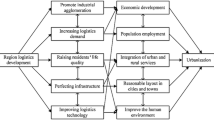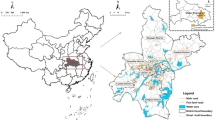Abstract
The complex landforms of a Shan-shui City (Shan-shui refers to mountains and rivers) significantly impact the selection of locations for logistics enterprises. This paper takes Chongqing, one of the most typical Shan-shui Cities in China, as the research object, and adopts spatial analysis methods and a mediating effect model, to explore the role of mountains and rivers in the formation of logistics enterprises’ spatial pattern on the street scale. The study results reveal that 90% of the logistics enterprises in the central urban areas of Chongqing are located in the low-altitude area below 353m above sea level, and distributed in a north-south direction along the mountains, as a result of blockage by mountain ranges, such as those of Zhongliang Mountain and Tongluo Mountain. More than 70% of the logistics enterprises are located less than 5 km from either the Yangtze River or Jialing River, spreading along the rivers. In addition, more than half of the logistics enterprises in commercial and financial, and residential land are located within the urban core area, while 80.83% of the logistics enterprises located in warehousing land and industrial land are concentrated in the urban expansion area. In areas with high land prices, the negative effect of altitude on logistics enterprise agglomeration is weakened, while the promotion effect of river proximity on logistics enterprise agglomeration is enhanced. In the urban core area with the advantage of low altitude and proximity to the Jialing and Yangtze Rivers, the role of mountains and rivers on logistics enterprises is not apparent; in contrast, in the urban expansion area with more complex landforms, land price can be an effective means for the government to macro-manage the spatial pattern of logistics enterprises in a Shan-shui City.
Similar content being viewed by others
References
Cao WD (2011) Spatial pattern and location evolution of urban logistics enterprises: Taking Suzhou as an example. Geogr Res-aust 30: 1997–2007. (In Chinese)
Chen SL, Chen HH, Li X (2020) The ability of nighttime imagery in monitoring economic activity in different scales. Scientia Geographica Sinica 40(09):1476–1483. (In Chinese)
Cidell J (2011) Distribution centers among the rooftops: the global logistics network meets the suburban spatial imaginary. Int J Urban Regional 35: 832–851. https://doi.org/10.1111/j.1468-2427.2010.00973.x
Dablanc L, Ogilvie S, Goodchild A (2014) Logistics sprawl: differential warehousing development patterns in Los Angeles, California, and Seattle, Washington. Transport Res Rec 2410(1): 105–112. https://doi.org/10.3141/2410-12
Fang J, Zhang MQ, Qiu HZ (2012) Mediation analysis and effect size measurement: retrospect and prospect. Psychological Development and Education 28: 105–111. (In Chinese)
Giuliano G, Kang S (2018) Spatial dynamics of the logistics industry: Evidence from California. J Transp Geogr 66: 248–258. https://doi.org/10.1016/j.jtrangeo.2017.11.013
Guerin L, Vieira JGV, Oliveira RLMD, et al. (2021) The geography of warehouses in the Sao Paulo Metropolitan Region and contributing factors to this spatial distribution. J Transp Geogr 91: 102976. https://doi.org/10.1016/j.jtrangeo.2021.102976
Guo XN, Su WC, Li Q, et al. (2016) Surface relief degree and its effects on ecosystem service value in the Chongqing Section of the Three Gorges Reservoir Region, China. Journal of Ecology and Rural Environment 32: 887–894. (In Chinese)
Hao SY, Wang WP (2012) The dynamic relationship research between house price and land price in China. On Economic Problems 36–45. (In Chinese)
He M, Zeng L, Wu XH, et al. (2019) The spatial and temporal evolution of logistics enterprises in the Yangtze River Delta. Sustainability 11: 5318. https://doi.org/10.3390/su11195318
Heitz A, Dablanc L, Olsson J, et al. (2020) Spatial patterns of logistics facilities in Gothenburg, Sweden. J Transp Geogr 88: 102191. https://doi.org/10.1016/j.jtrangeo.2018.03.005
Hesse M, Rodrigue J (2004) The transport geography of logistics and freight distribution. J Transp Geogr 12: 171–184. https://doi.org/10.1016/j.jtrangeo.2003.12.004
Hewings G (1975) Threshold analysis and urban development: An evaluation. The Annals of Regional Science 9: 21–31.
Holl A, Mariotti I (2018) The geography of logistics firm location: the role of accessibility. Netw Spat Econ 18: 337–361. https://doi.org/10.1007/s11067-017-9347-0
Hong JJ, Chin ATH (2007) Modeling the location choices of foreign investments in Chinese logistics industry. China Econ Rev. https://doi.org/10.1016/j.chieco.2006.07.001
Jiang TY, Shi YN (2015) The spatial pattern evolution and influencing factors of logistics enterprises in Ningbo. Econ Geogr 35: 130–138. (In Chinese)
Li Gq, Jin Fj, Chen Y, et al. (2015) Spatial patterns of logistics industry based on a geographic analysis of hotness degree. Progress in Geography 34: 629–637. (In Chinese)
Li GQ, Jin FJ, Chen Y, et al. (2017) Location characteristics and differentiation mechanism of logistics nodes and logistics enterprises based on points of interest (POI): A case study of Beijing. J Geogr Sci 27: 879–896.
Liang SB, Cao YH, Wu W (2013) Spatial pattern evolution of port logistics enterprises in Shanghai metropolitan area. Geogr Res-aust 32: 1448–1456. (In Chinese)
Liu CL (2004) Empirical Analysis on the Spatial Structure of Logistics Economic Lingkages in China Mainland. Econ Geogr 6. (In Chinese)
Lü F (2015) “Shadow Employees” and “Concentric Circles” in Chinese Local Governments: An Empirical Analysis Based on Street Offices. Management World (10):106-116. (In Chinese)
MacKinnon DP, Lockwood CM, Williams J (2004) Confidence limits for the indirect effect: Distribution of the product and resampling methods. Multivar Behav Res 39: 99–128. https://doi.org/10.1207/s15327906mbr3901_4
O’Connor K (2010) Global city regions and the location of logistics activity. J Transp Geogr 18: 354–362. https://doi.org/10.1016/j.jtrangeo.2009.06.015
Páez A, Anjum Z, Dickson-Anderson SE, et al. (2020) Comparing distance, time, and metabolic energy cost functions for walking accessibility in infrastructure-poor regions. J Transp Geogr 82: 102564. https://doi.org/10.1016/j.jtrangeo.2019.102564
Pan FJ, Wan Q, Feng B, et al. (2021) Multi-scale Analysis of Spatial Pattern Characteristic of the Logistics Companies in China. Econ Geogr 41(06):97–106. (In Chinese)
Pan YJ, Cao XS (2012) Spatial patterns and their formation mechanism of supply logistics network of wholesale markets in Guangzhou. Acta Geographica Sinica 67: 179–188. (In Chinese)
Qian QL, Chen YB, Li Y, et al. (2011) Spatial distribution of logistics enterprises in Guangzhou and its influencing factors. Geogr Res-aust 30: 1254–1261. (In Chinese)
Rivera L, Sheffi Y, Knoppen D (2016) Logistics clusters: The impact of further agglomeration, training and firm size on collaboration and value added services. Int J Prod EconC 17:, 285–294. https://doi.org/10.1016/j.ijpe.2016.05.018
Rivera L, Sheffi Y, Welsch R (2014) Logistics agglomeration in the US. Transport Res A-Pol 59: 222–238. https://doi.org/10.1016/j.tra.2013.11.009
Saiz A (2010) The geographic determinants of housing supply. The Quarterly Journal of Economics 125: 1253–1296. https://doi.org/10.1162/qjec.2010.125.3.1253
Sakai T, Beziat A, Heitz A (2020) Location factors for logistics facilities: Location choice modeling considering activity categories. J Transp Geogr 85: 102710. https://doi.org/10.1016/jjtrangeo.2020.102710
Sakai T, Kawamura K, Hyodo T (2015) Locational dynamics of logistics facilities: Evidence from Tokyo. J Transp Geogr 46: 10–19. https://doi.org/10.1016/jjtrangeo.2015.05.003
Sakai T, Kawamura K, Hyodo T (2016) Logistics facility distribution in Tokyo Metropolitan Area: Experiences and policy lessons. Transportation Research Procedia 12: 263–277. https://doi.org/10.1016/j.trpro.2016.02.064
Shi KF, Yu BL, Huang YX, et al. (2014) Evaluating the ability of NPP-VIIRS nighttime light data to estimate the gross domestic product and the electric power consumption of China at multiple scales: A comparison with DMSP-OLS data. Remote Sens-Basel 6(2): 1705–1724. https://doi.org/10.3390/rs6021705
Strale M (2020) Logistics sprawl in the Brussels metropolitan area: Toward a socio-geographic typology. J Transp Geogr 88: 102372. https://doi.org/10.1016/jjtrangeo.2018.12.009
Tang JR, Zhang XH (2017) Spatio-temporal Evolution, Driving Forces and Spillover Effects of Logistics Industry Development: On Spatial Panel Data Analysis of Chinese Provincial Panel Data. Finance and Trade Research 28(05):11–21. (In Chinese)
Verhetsel A, Kessels R, Goos P, et al. (2015) Location of logistics companies: a stated preference study to disentangle the impact of accessibility. J Transp Geogr 42: 110–121. https://doi.org/10.1016/jjtrangeo.2014.12.002
Wang CJ (2005) Model about Spatial Organization of Logistics Economy in China. Econ Geogr (03):366-368. (In Chinese)
Wang CJ (2008) Spatial Organizational Network of Loigsitcs Company in China. Acta Geographica Sinica (02):135-146. (In Chinese)
Wang CJ, Zhang MT (2014) Spatial pattern and its mechanism of modern logistics companies in China. Progress in Geography (01): 134–144. (In Chinese)
Ye G, Zhu KW, Zhang JH (2016) The Causality between Housing Price and Land Price based on Empirical Test in Chongqing. China Land Sciences 30(06):62–70. (In Chinese)
Zhang D, Cao WD, Fan JJ (2014) The spatio-temporal evolution characteristics and mechanism of Yangtze River Delta city logistics development efficiency. Econ Geogr 34: 103–110. (In Chinese)
Zhang LL, Zhao JL, Song JP, et al. (2019) Spatial evolution and influencing factors of logistics enterprises in Beijing-Tianjin-Hebei Urban Agglomeration. Econ Geogr 39(03):125–133. (In Chinese)
Zhu H, Zhou GG, Ren GY (2015) Research on Spatial Co-Agglomeration Between Manufacturing Industry and Logistics Industry—A Case Study of Six Provinces in Central China. Scientia Geographica Sinica 35(11):117–124. (In Chinese)
Zong HM, Wang PC, Dai JC (2015) The Spatial Layout of Logistics Parks in Chongqing Urban Area and Its impacts on the Urban Structure. Scientia Geographica Sinica 35(07):831–837. (In Chinese)
Zweers BG, Bhulai S, Van der Mei RD (2019) Optimizing barge utilization in hinterland container transportation. Nav Res Log (NRL) 66: 253–271. https://doi.org/10.1002/nav.21837
Acknowledgement
This work was supported by the National Natural Science Foundation of China (Grant No. 72173101) and sponsored by Natural Science Foundation of Sichuan, China (2022NSFSC0417).
Author information
Authors and Affiliations
Corresponding author
Rights and permissions
About this article
Cite this article
Liu, Sj., Zhu, Cj., He, Nn. et al. Role of mountains and rivers in the formation of logistics enterprises’ spatial pattern in the central urban areas of Chongqing. J. Mt. Sci. 19, 2060–2074 (2022). https://doi.org/10.1007/s11629-021-7229-x
Received:
Revised:
Accepted:
Published:
Issue Date:
DOI: https://doi.org/10.1007/s11629-021-7229-x




